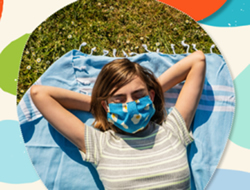Heather Landy* discusses what happens to working parents when the kids are not alright?
 When you have a child with mental health struggles, balancing work and home life can be even trickier than usual.
When you have a child with mental health struggles, balancing work and home life can be even trickier than usual.
The hours needed to arrange and participate in their care, the emotional exhaustion of parenting through this period—it all takes a toll.
Modern Health, which connects employees of participating employers to a variety of mental health resources, says the number of employee dependents under age 18 using its therapy offerings jumped 360 per cent this year through early May versus the same period last year.
But what can you do if your employer doesn’t offer assistance in finding or subsidizing mental health care for your kids?
In a recent interview with Quartz, psychologist Julia Corcoran, who is the director of clinical strategy and experience at Modern Health, recommended several actions parents can take, along with context for understanding the deepening mental health crisis among children and teenagers.
The following transcript has been lightly edited for length and clarity.
Quartz: What is the need that you’re seeing from parents of teenagers and pre-teens?
Corcoran: I think it’s helpful to start pre-pandemic.
For children and adolescents, their mental health needs were already quite high, but not really recognized outside of the parents who happened to know that their child was struggling, and mental health professionals.
The pandemic has really exposed a lot more stress, in conjunction with stress being much, much higher.
And so I think those two things have come together and converged to really expose much higher levels of mental health needs in children and adolescents than was previously acknowledged.
The World Health Organization reports that 1 in 7 people up to age 19 have experienced some form of mental health disorder.
That number statistically is not too out of line with adults.
However, when we dig into that, we start to find some really alarming things.
Suicide is the fourth-leading cause of death for 15- to 19-year-olds in the world.
In the United States, it’s the second-leading cause of death.
From 2001 to 2019, the suicide rate for adolescents in the US jumped by 40 per cent.
And then there’s something that in mental health we call non suicidal self-injury, referred to briefly as self-harm, which is not with the intent of dying.
We see that in about 15 per cent to 30 per cent of children and adolescents, depending on which study you look at, versus for adults we see that in about 5 per cent.
So there really are consequences here for this age range that are just different, and much scarier.
What do you think employers could or should be doing as a result?
If we take sort of the mildest possible case, say we have a child or a teen who needs to get to a weekly therapy appointment, there are logistics—they have to get there somehow.
But really good treatment is also going to involve some amount of checking in with the parents, depending on the child’s age and needs.
So one or both parents really need to be present for some of those therapy sessions.
Or, we might be having family sessions, and we might be having meetings with teachers or for IEPs so that we can get special accommodations at school.
And then things really just go up from there, all the way up to kids who need to be hospitalized, or maybe they’re in intensive outpatient programs that are several hours a day.
Those almost invariably involve the parents coming for probably a couple hours out of their workweek.
If you have a kid who is self-harming, or who is suicidal or potentially having those thoughts, then you also need to be able to drop everything and go help them stay safe at any moment.
So, flexibility in terms of when the parent can check in and out of work—it’s just absolutely critical.
You cannot function as a parent in these situations if you don’t have an employer who is willing to let you cut out of a meeting early or plug in later because you need to check on your child.
Certainly benefits that are going to cover the child’s care and treatment [are helpful].
If we’re getting to the point where the child or the teen is in weekly therapy, but especially if we’re doing outpatient programs or hospitalization, those things are very pricey and most people cannot afford them out of pocket.
Even then, it’s exceedingly hard these days to find childhood mental health providers who take insurance.
Right, or there’s a six-month waiting list.
Meanwhile, your child is telling you that they’re thinking about harming themselves today.
So waiting six months is not a viable option.
What’s your advice to parents who don’t have dependent-care mental health benefits yet find their children in need?
Depending on where you live, there may be community clinics that can serve folks that either don’t have insurance or have insurance that doesn’t include mental health benefits.
A lot of times they’re staffed with newer therapists.
But there’s evidence to show that even newer, trainee therapists can make a big difference.
Remember, they’re highly supervised and they’re very motivated to do well.
If you can, find online modules for dialectical behaviour therapy, or DBT.
It’s going to be much better if you can do it with a therapist, but if focuses a lot on emotion regulation, connecting with others, distress tolerance.
Even as a therapist learning DBT, I remember thinking, “Wow, I wish I’d learned these skills when I was 10.”
And especially if your kid is a little isolated, see if there’s anything that can get them to connect with people, ideally offline: an art class, swimming, Dungeons & Dragons.
We know that social support is one of the most important things for improving our mental health.
What else should parents keep in mind as their kids enter the teenage years?
For a lot of people, there is a really notable change between parenting during the child years and the adolescent years.
Even with a perfectly healthy, well-functioning teen, it becomes a much more emotionally laden time to be a parent.
That being said, I do think with increasing awareness and willingness to talk about mental health, it does seem like there’s also increasing numbers of parents of younger kids saying, “Hey, I think my kid could probably use a little bit of support, they seem a little more anxious than I think they should be,” or, you know, “I‘d like to get them a little bit more mental healthcare earlier in life.”
And I think a lot of that is just awareness and not necessarily that there’s increasing distress.
But I was just talking to a grade school principal the other day and she was saying, “I just never thought part of my job would be calling parents about kids saying they have suicidal thoughts. And yet that is a part of my job.”
Beyond social media or the covid-19 pandemic, is there anything else that you think is a big contributor to these increases in mental health issues?
I do think—and this also could potentially be attributed to social media—that the sort of extremism that we’re seeing in politics is really infusing into daily life.
Kids see these things, and they start to pick up on how we’re talking to each other or about each other.
We’re very social creatures, so if we’re starting to feel like, well, none of us seem to feel safe around this entire half of the country, that really is going to have an impact.
I also think we can’t overlook the opioid crisis and increasing access also to marijuana and CBD, especially in youth.
There are correlations between marijuana use and increased mental health distress.
So as those things become more and more a part of the daily culture, we just need to think, how is that showing up in our children’s lives and impacting them?
It’s also really important that we think about BIPOC communities, immigrant communities—there are all these communities we already know are under-resourced, marginalized, and historically have not had great interactions with our medical system.
All of that is just exacerbated when we get to the child’s level.
We see it in schools, for instance, where black male children are often called disruptive, when the same behaviour from a white male child might be called ADHD, and then they get treatment.
And so there are just these systemic problems that are we’re going to see affecting kids.
Are we entrenching inequality when we allow children’s mental healthcare to become a workplace benefit? Is there a risk to society that we’re splitting even further into haves and have-nots?
I could not agree with that more.
If they have the money, then parents might pay someone to get the child to the appointment.
Or maybe they’re lucky enough to have family or a neighbour or someone else to help.
But that still is cutting the child’s experience very short in that treatment because the parent really does need to be there for some of it.
If you happen to have resources, you can probably make this work.
But that’s really not, I don’t think, an acceptable way for us in society to be caring for children.
There needs to be a safety net that goes beyond employers, that goes beyond the individual parent’s circumstances.
*Heather Landy is Executive Editor of Quartz.
This article first appeared at qz.com.











